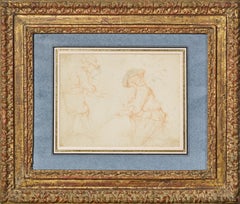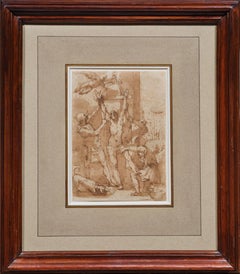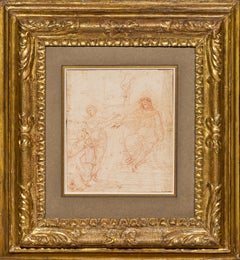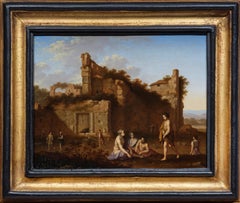Want more images or videos?
Request additional images or videos from the seller
1 of 11
Leonaert BramerSilvio and Dorinda, a drawing by Leonaert Bramer, Vermeer's first master1655-1665
1655-1665
Price:$6,919.24
$8,122.59List Price
About the Item
- Creator:Leonaert Bramer (1596 - 1674)
- Creation Year:1655-1665
- Dimensions:Height: 10.88 in (27.64 cm)Width: 12.25 in (31.12 cm)
- Medium:
- Movement & Style:
- Period:1650-1659
- Condition:Pen and grey ink, grey wash and white gouache highlight on yellow-washed laid paper 7 ½” x 8 7/8” (190 x 225 mm) - Framed : 10 7/8” x 12 ¼” (27.5 x 31 cm) Signature lower right Bramer Carved fruitwood frame - 18th century or earlier - Lorraine ?
- Gallery Location:PARIS, FR
- Reference Number:1stDibs: LU1568215415852
About the Seller
5.0
Vetted Professional Seller
Every seller passes strict standards for authenticity and reliability
Established in 2020
1stDibs seller since 2021
10 sales on 1stDibs
Authenticity Guarantee
In the unlikely event there’s an issue with an item’s authenticity, contact us within 1 year for a full refund. DetailsMoney-Back Guarantee
If your item is not as described, is damaged in transit, or does not arrive, contact us within 7 days for a full refund. Details24-Hour Cancellation
You have a 24-hour grace period in which to reconsider your purchase, with no questions asked.Vetted Professional Sellers
Our world-class sellers must adhere to strict standards for service and quality, maintaining the integrity of our listings.Price-Match Guarantee
If you find that a seller listed the same item for a lower price elsewhere, we’ll match it.Trusted Global Delivery
Our best-in-class carrier network provides specialized shipping options worldwide, including custom delivery.You May Also Like
'Leaving the Garden of Eden', Mid-century American Expressionist, Adam and Eve
Located in Santa Cruz, CA
Signed lower right, 'John T Stephens' (American, 20th century) and painted circa 1965; additionally inscribed, verso, with title, 'Leaving the Garden of Eden' and signed.
Paper dime...
Category
1960s Figurative Drawings and Watercolors
Materials
Acrylic, Gouache, Laid Paper
$1,650
H 19.25 in W 22.25 in
Nature through the Mirror Nude and with a Whirlwind Style of Childe Hassam
Located in Soquel, CA
Nature through the Mirror Nude and with a Whirlwind Style of Childe Hassam
Exquisite watercolor on card stock in the style of Childe Hassam by American Impressionist Wilhelmina (Minn...
Category
1910s Post-Impressionist Figurative Drawings and Watercolors
Materials
Watercolor, Laid Paper, Postcard
Wilhelmina Olson UhlNature through the Mirror Nude and with a Whirlwind Style of Childe Hassam, 1812
$2,180
H 12.5 in W 7.5 in D 0.5 in
Expressionist Figurative water color painting- Series Bath NO.5
Located in Beijing, CN
Artist Biography
Zhang Chunyang was born in 1975 in Changchun, Jilin. She earned her B.F.A at Jilin University of Arts in 1999, and studied at Central Acadamy of Fine Arts, Beijing ...
Category
2010s Expressionist Nude Paintings
Materials
Watercolor, Gouache, Handmade Paper
$3,040
Free Shipping
H 11.42 in W 14.18 in
Expressionist Figurative water color painting- Series Bath NO.1
Located in Beijing, CN
Artist Biography
Zhang Chunyang was born in 1975 in Changchun, Jilin. She earned her B.F.A at Jilin University of Arts in 1999, and studied at Central Acadamy of Fine Arts, Beijing ...
Category
2010s Expressionist Nude Paintings
Materials
Watercolor, Gouache, Handmade Paper
$3,040
Free Shipping
H 11.42 in W 14.18 in
1960s "Leaning Over" Gouache & Oil Pastel Bay Area Figurative Movement
By Gloria Dudfield
Located in Arp, TX
Gloria Dudfield
"Leaning Over"
c. 1960s
Gouache and charcoal on newsprint
Unsigned
18" x 12" framed silver bamboo frame black mat 19.25"x25.25"
Gloria...
Category
Mid-20th Century American Modern Figurative Drawings and Watercolors
Materials
Paper, Oil Pastel, Gouache
$480 Sale Price
45% Off
H 25.25 in W 19.25 in D 0.5 in
Les fleurs du mal by Erté
By Erte - Romain de Tirtoff
Located in New Orleans, LA
Erté (Romain de Tirtoff)
1892-1990 Russian-French
Fleurs du Mal(The Flowers of Evil)
Signed "Erté" (lower right)
Inscribed 114.6 (en verso)
Gouache on paper
Captivating and vibrant, this colorful gouache entitledFleurs du Mal showcases Erté's masterful creativity and keen eye. Inspired by Les Fleurs du mal, the famed volume of poems by French writer Charles Baudelaire, this ensemble marries light purple and green floral motifs with the suggestive form of red lips poised for a smooch. This daring yet feminine appearance encapsulates the Art Deco allure for which the artist's creations are cherished. The sophisticated arrangement emanates the fundamental richness and theatricality that can only be accomplished by Erté, often hailed as the "Father of Art Deco."
First published in 1857, Baudelaire's Les Fleurs du mal was controversial for its suggestive content and themes of decadence and eroticism. The volume provided a wealth of inspiration for Erté and he drew from several themes to create original fashion sketches...
Category
20th Century Art Deco Figurative Drawings and Watercolors
Materials
Paper, Gouache
$18,500
H 20.75 in W 16.875 in D 0.75 in
Judith Brenner, Sophie Seated 3, Original Figurative Painting, Nude Artwork
By Judith Brenner
Located in Deddington, GB
Judith Brenner
Sophie Seated 3
Original Figurative Painting
Mixed Media on Paper
Size: H 84.1cm x W 59.4cm x D 0.1cm
Sold Unframed
Please note that insitu images are purely an indication of how a piece may look.
Sophie Seated 3 is a contemporary nude painting by Judith Brenner. This is an original drawing from life on paper using acrylic, pan pastel , ink and watercolour pencil. The idea is to capture the essence of the pose using line and wash...
Category
21st Century and Contemporary Minimalist Figurative Drawings and Waterco...
Materials
Paper, Pastel, Ink, Mixed Media, Acrylic, Watercolor
$1,361
Free Shipping
H 33.12 in W 23.39 in D 0.04 in
Judith Brenner, Solfrid Dancing 2, Original Contemporary Figurative Nude Sketch
By Judith Brenner
Located in Deddington, GB
Judith Brenner
Solfrid Dancing 2
Original Figurative Drawing
Acrylic Paint, Pan Pastel, Ink and Watercolour Pencil on Paper
Sheet Size: 84.1cm x W 59.4cm x D 0.1cm
Sold Unframed
Plea...
Category
21st Century and Contemporary Abstract Impressionist Figurative Drawings...
Materials
Paper, Pastel, Ink, Mixed Media, Acrylic, Watercolor
$1,362
Free Shipping
H 33.12 in W 23.39 in D 0.04 in
"Female Nudes" Pink, Blue, Yellow, and Black Abstract Modern Figurative Drawing
By Charles Pebworth
Located in Houston, TX
Pink, sky blue, yellow, and black abstract modern figurative drawing by Houston, TX artist Charles Pebworth. The drawing depicts four nude women behind what appears to be windows. Si...
Category
1980s Abstract Figurative Drawings and Watercolors
Materials
Watercolor, Pen
$1,600
H 17.25 in W 16.88 in D 0.5 in
Water Sports - Coney Island Nude Swimmers and Nude Bathers
By Reginald Marsh
Located in Miami, FL
Presented in a good broad craved and antiqued giltwood frame in the Spanish Baroque style. Each corner boldly carved with a stylized anthemion mantled by foliate scrolls. The beauti...
Category
1940s Realist Figurative Drawings and Watercolors
Materials
India Ink, Watercolor
$68,000
H 26.5 in W 39.5 in
More From This Seller
View AllStudy for a Hunting Scene, a red chalk sketch attributed to Karel du Jardin
Located in PARIS, FR
We would like to thank Carolina Trupiano Kowalczyk for suggesting this attribution to Karel du Jardin after direct examination of the artwork. Her study of the drawing (in Italian), ...
Category
1650s Old Masters Figurative Drawings and Watercolors
Materials
Chalk, Ink, Laid Paper
The Martyrdom of Saint Bartholomew, a preparatory drawing by Alessandro Casolani
Located in PARIS, FR
This powerful pen and brown ink wash drawing is a study for an altarpiece depicting The Martyrdom of Saint Bartholomew. Signed and dated 1604, it was painted at the end of his life b...
Category
Early 1600s Old Masters Figurative Drawings and Watercolors
Materials
Ink, Pen
Studies for the Judgment of Solomon, a double-sided drawing by Simone Cantarini
Located in PARIS, FR
In this double-sided red chalk study, Simone Cantarini offers us a double reflection on the theme of the Judgment of Solomon. This sheet reveals his precise style and his sense of de...
Category
1640s Old Masters Figurative Drawings and Watercolors
Materials
Chalk, Laid Paper
Gathering in antique Ruins, a monogrammed painting by Jan van Haensbergen
By Jan Van Haensbergen
Located in PARIS, FR
Jan van Haensbergen was a painter of the Dutch Golden Age and a pupil of Cornelius van Poelenburgh (Utrecht 1594 - 1667). The painting we are presenting is inspired by Poelenburgh’s landscapes from his Italian sojourn. The dreamlike atmosphere of this Gathering in antique ruins appealed to us. Against a backdrop of antique ruins, three draped characters (perhaps bathers) are sitting in a circle, greeting a fourth character walking towards them.
Their tranquility contrasts with the bustle of the other characters in the background. They constitute a vivid illustration of otium, this leisure time that allows us to realize our full potential. With this Arcadian landscape, Jan van Haensbergen invites us in turn to leave the hustle and bustle of everyday life behind, to take a break, to enjoy the present moment chatting with close friends…
1. Jan van Haensbergen, a landscape and portrait painter of the Dutch Golden Age
Jan van Haensbergen was born in 1642 in Gorinchem, a town in southern Holland to the east of Rotterdam. He was a pupil of Cornelius van Poelenburgh, and began by painting landscapes inspired by those of his master, in an Italianate style. Between 1668 and 1669, he was registered at the Guild of Saint Luke in Utrecht.
In 1669, he moved to The Hague, where he joined the Confrérie Pictura, an artist society founded in 1656. His portraits, which became his main activity as a painter after settling in The Hague, were strongly influenced by Caspar Netscher (Prague or Heidelberg 1639 - The Hague 1684), whom he met in The Hague and whose son Constantijn became his son-in-law by marrying his daughter Magdalena.
In addition to his work as an artist, Van Haensbergen was also an art dealer, probably helped by his appointment as Dean of the Confrérie Pictura, where he also teached.
2. Description of the artwork and related paintings
This painting seems to us to be a kind of allegory of otium, that quiet bliss promised by Epicurus. It might even evoke an Epicurean proverb: "It is better to lie on the naked ground and be at ease, than to have a golden carriage and a rich table and be worried" .
Three draped young people - two men and a woman in the background - are seated in a circle, greeting a fourth figure walking towards them, hair disheveled and body draped in a towel as if drying off after a bath, indicating the need for prior purification to fully enjoy this rest. Their nonchalance contrasts with the bustle of the various characters in the background.
The composition is punctuated by successive diagonals, and opens onto a landscape on the right, with a succession of mountainous planes. This painting is typical of the Italianate works produced by Van Haensbergen in the 1660s under the influence of Cornelis van Poelenburgh...
Category
17th Century Old Masters Landscape Paintings
Materials
Oak, Oil
Diana and Actaeon, a Mannerist painting after Joseph Heintz the Elder
Located in PARIS, FR
This painting seduced us with its rich colors. Depicting Diana and her companions surprised by Actaeon, it was inspired by an engraving by Aegidius Sadeler II after a painting by Jos...
Category
17th Century Old Masters Nude Paintings
Materials
Oil, Wood Panel
Frieze of antique figures, a drawing by the sculptor Antoine-Denis Chaudet
Located in PARIS, FR
Faithful to the neo-classical taste, sculptor Antoine-Denis Chaudet presents us with a frieze of antique figures executed in gray wash over pencil strokes, which is likely inspired b...
Category
Early 1800s Old Masters Figurative Drawings and Watercolors
Materials
Paper, Pencil, Ink
Recently Viewed
View AllMore Ways To Browse
Vermeer Paintings
Young Hunter
Antique Javelin
Contemporary Delft
1930s Fashion Drawing
C Huber
Cardinal Watercolor 19th Century Painting
Couple Walking Painting
Ephraim Samson
Erte Gouache 1940
Frederic Bruly Bouabre
George Anderson Short
George Frederic Watts
Gordon Phillips
Jean Effel
Man With Violin
Miniature Saddle
Mordi Gassner



